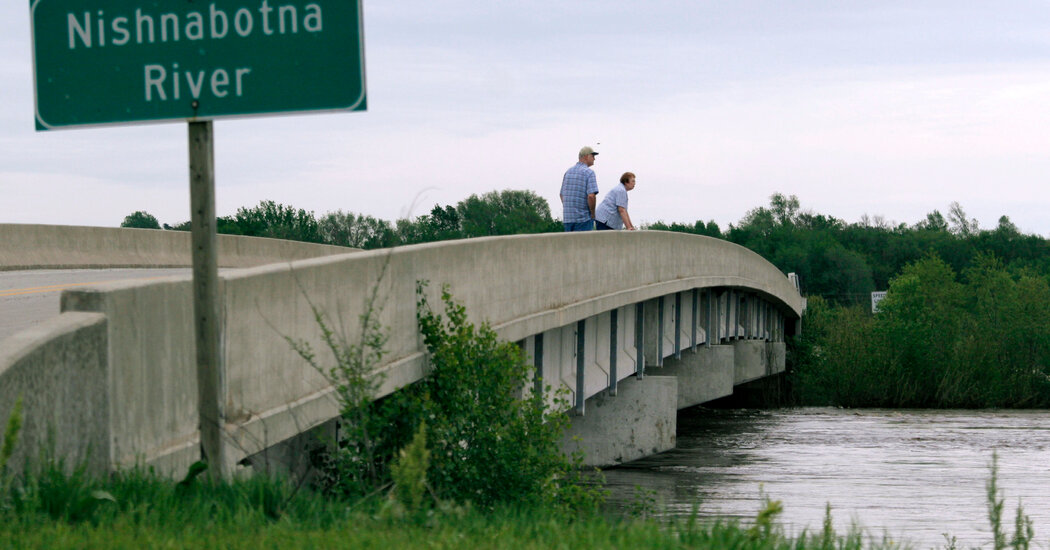A fertilizer spill in Iowa this month wiped out much of the aquatic life across a 60-mile stretch of rivers in two states, officials said, leaving an estimated 789,000 fish dead in one of the region’s most ecologically devastating chemical spills in recent years.
A Missouri official who surveyed the damage said that the banks of the Nishnabotna River had been lined with fish carcasses, and that dead fish were visible through the water.
“I refer to this one as ‘the big one,’” said the official, Matt Combes, an ecological health unit science supervisor for the Missouri Department of Conservation. He added: “Calling something a near-total fish kill for 60 miles of a river is astounding and disheartening.”
While fish kills on that scale are unusual, smaller kills are common. Comparing the scope of fish kills across different states is difficult because of limited data and tracking, experts said.
The latest die-off started, Iowa officials said, when a valve was left open over a weekend on a storage tank at NEW Cooperative, an agricultural business in Red Oak, in southwestern Iowa. The Iowa Department of Natural Resources, which learned of the spill on March 11, said this week that 265,000 gallons of liquid nitrogen fertilizer spilled into a drainage ditch and into the East Nishnabotna River, which flows into the Nishnabotna River and then the Missouri River.
Iowa officials estimated that more than 749,000 fish died in that state. Most of them were small species, such as minnows and shiners, but thousands of larger fish, including catfish and carp, also perished. Mr. Combes, the Missouri official, estimated that around 40,000 fish died in his state. He said he saw large catfish dead, as well as shovelnose sturgeon.
The fish kill was one of the five largest on record in Iowa, according to state data, and the worst since runoff from a dairy farm in 2013 killed more than 800,000 fish. The federal Environmental Protection Agency does not keep similar data on the national level, a spokesman said.
“People would be surprised how many small to moderate-size kills there are in the United States,” said Andrew Loftus, a fisheries biologist and co-author of a book that is widely used to assess the monetary damages related to small and medium fish kills. “We just don’t have a number of them. But they are happening quite frequently.”
Fish kills are often caused by contaminants including fertilizer or industrial chemicals. They can also stem from releases of sewage from water treatment plants or heated water from power plants.
On a national scale, the fish kill in Iowa and Missouri was considered a medium to large event, according to fisheries experts.
“Certainly the length of river affected is pretty large and the numbers large,” said Gary Whelan, a vice president at the American Fisheries Society, a nonprofit focused on aquatic conservation and fisheries management. “But the biomass affected is likely pretty low as the kill was mostly minnow and chub species.”
A spokesman for NEW Cooperative declined to comment on Friday. A spokeswoman for the Iowa Department of Natural Resources declined to make officials available for interviews, citing “anticipated litigation.”
The ecosystem could take decades to fully recover, Mr. Loftus said.
At the spill site, contaminated soil and tainted water was still being removed, Iowa officials said. Mr. Combes said some pollutants had flowed into the much larger Missouri River, but there had been no immediate fish kill there.
Water contamination from agricultural nitrates has been a longstanding issue in Iowa. But the policy changes that environmental advocates desire have been a tough political sell in a state where Republicans run the legislature and farming powers the economy.
“I’m not really holding my breath,” said Alicia Vasto, the water program director for the Iowa Environmental Council, a nonprofit group that wants more stringent regulations. “But I really hope that this kind of wakes some people up to the sad situation of our waterways here.”


